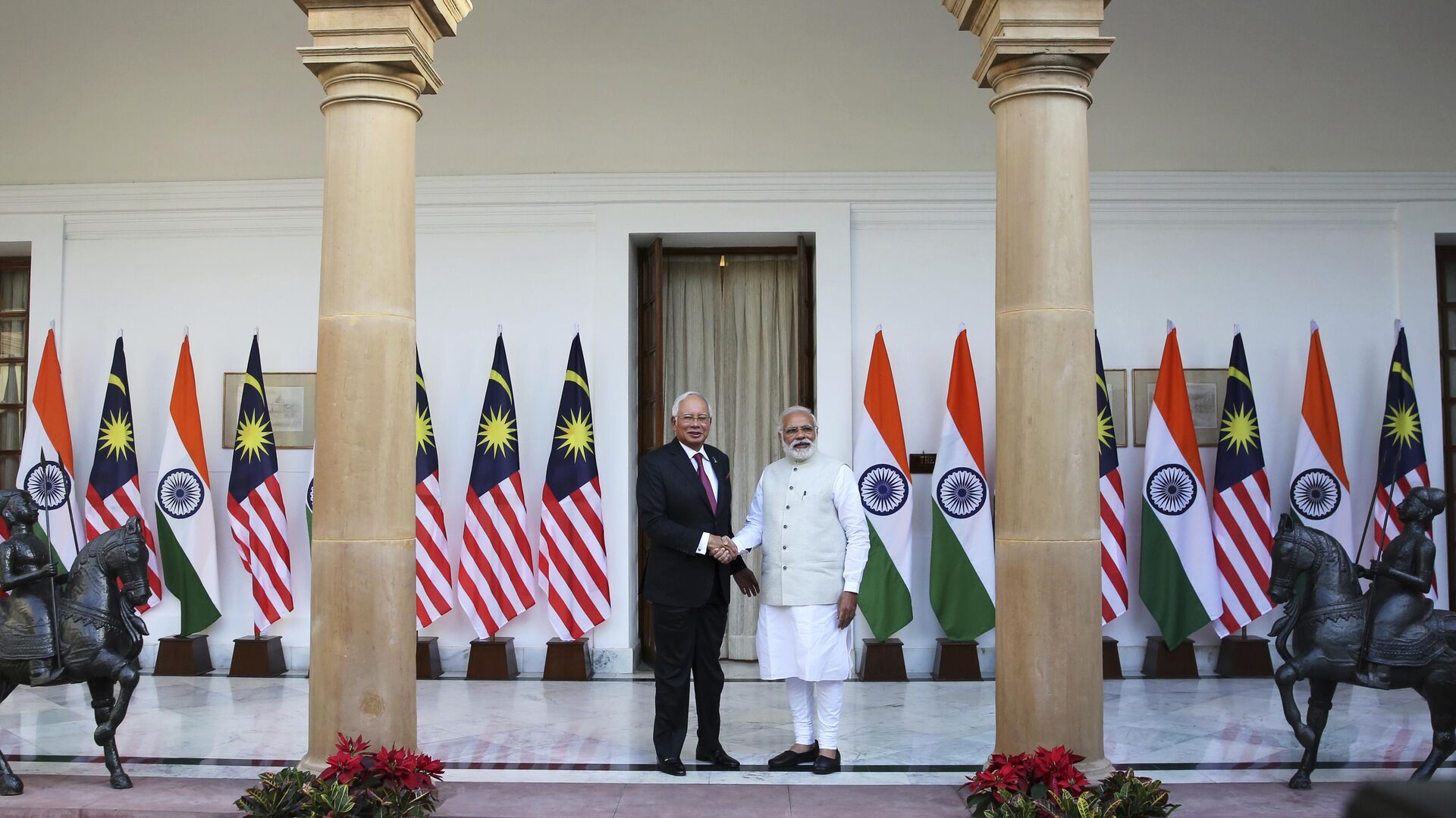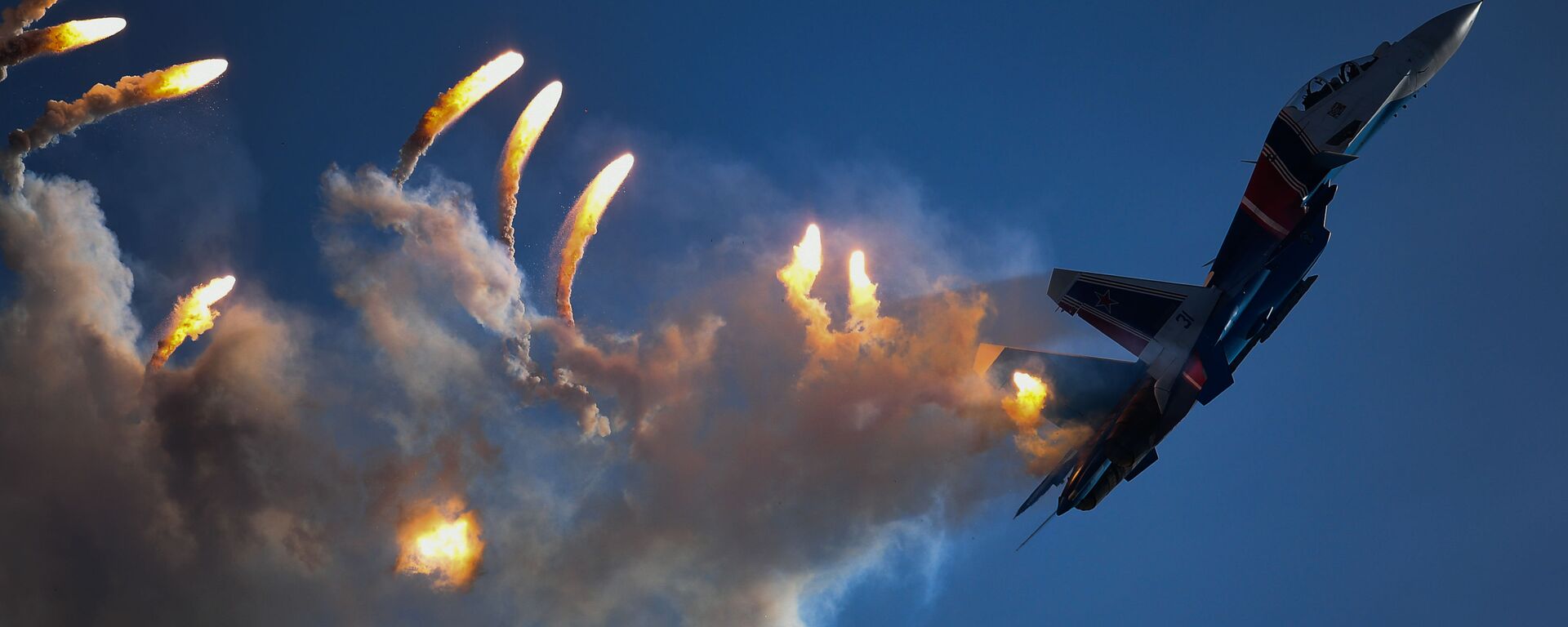https://sputniknews.in/20230919/india-malaysia-review-defence-and-industry-partnership-4331794.html
India-Malaysia Review Defence And Industry Partnership
India-Malaysia Review Defence And Industry Partnership
Sputnik India
India and Malaysia held their 10th Joint Sub-Committee meeting on Defence Science, Technology, and Industry Cooperation in New Delhi on Monday.
2023-09-19T20:29+0530
2023-09-19T20:29+0530
2023-09-19T20:29+0530
explainers
indian navy
malaysia
india
china
asean
south asia
south china sea
south-south cooperation
new delhi
https://cdn1.img.sputniknews.in/img/07e7/09/13/4337931_262:0:3903:2048_1920x0_80_0_0_7e5bbe6b5248ef6f385905f837ef7d3c.jpg
India and Malaysia held their 10th Joint Sub-Committee meeting on Defence Science, Technology, and Industry Cooperation in New Delhi on Monday.India and Malaysia, according to an Indian Defense Ministry communique, reviewed their current defence research and industry partnership and discussed topics of mutual interest during the meeting."Both sides investigated efficient and doable initiatives to expand continuing interactions related to the defence industry sector," the press release stated. The meeting was attended by senior officials Rajeev Prakash, Joint Secretary (Naval Systems), Department of Defence Production, Ministry of Defence and Eris Jemadi bin Tajudin, Under-Secretary, Ministry of Defence of Malaysia. Is India Changing Its Approach to South-East Asia? India's reinvigorated approach to South-east Asia, in general, and Malaysia in particular, is in stark contrast to the period before 1990 when the region was largely neglected in the country's foreign and defence policy procedures.India's policy has undergone a noticeable change that aims to strengthen its ties with the Association of South-east Asian Nations (ASEAN) as well as its defence partnerships and cooperative relationships with specific ASEAN nations, opening the door for defence diplomacy to play a significant role in bilateral relations.India, Malaysia Historical Relations: Cholas to British EmpireIndia and Malaysia have long-standing historical ties, which, as a result of their shared commerce and cultural heritage, have led to even closer political and economic ties in the present. The cultural and commercial links between the two countries actually date back to before British colonial rule to the later Chola period, which was a thriving empire in southern India around the 8th century AD that was renowned for its maritime prowess.The apex of Tamils' historical past has been the Chola expeditions against Sri Vijaya state in Sumatra, Indonesia. In the years following independence, partnerships with South-east Asian nations, especially Malaysia, were able to grow with more vigour because of their shared history.Similarly, the literature demonstrates that Indian soldiers fought alongside the British in the Second World War to fend off the Japanese invasion of Singapore and Malaya. In fact, the British government's decision to use native Indian sepoys to defend its national security interests is what gave Indians the chance to reside in Malaysia and developing strong defence ties.Why is Malaysia important to India?The Bay of Bengal separates these marine neighbours from one another. India is a peninsular nation, with a 7,500km coastline.India and Malaysia are only 50 miles apart because of the Andaman and Nicobar Islands' central oceanic location. In fact, the distance between these islands and Malaysia is substantially smaller.Malaysia is the only nation that is part of both mainland South-east Asia and the archipelago that spreads westward from the Philippines to the Indonesian island of Sumatra, making it the obvious focal point of the region on a map of South-east Asia. It is ideally situated as a crossing point between the Indian Ocean and the South China Sea and like many other countries with vast coastlines, Malaysia relies heavily on the water for its economic activities.80 percent of Malaysia’s shipping flows through the Strait of Malacca, which connects three significant waterways: the Indian Ocean, the Pacific Ocean, and the South China Sea, making it a source of national security.The Indian Ocean Rim states are vital trade partners for Malaysia and India is the largest consumer of Malaysia's palm oil exports. In 2019, India and Malaysia’s economic ties were strained after Malaysia's then Prime Minister, Mahathir Mohamad, speaking at the UN General Assembly turned his fire on India over the Jammu and Kashmir administration, urging New Delhi to work with Islamabad to resolve the issue.Defence Cooperation: Military training to BrahMosIndia and Malaysia signed a Memorandum of Understanding (MOU) in February 1993, the first formal bilateral defence pact between the two nations in the post-Cold War era. It represents a fresh start for the two countries' relations in line with the Act East Policy framework that India had in place at the time.After the signing of the MoU, defence cooperation improved with the formation that year of the Malaysia-India Defence Cooperation Committee (MIDCOM). The committee then met often to discuss issues concerning training and the exchange of defence personnel, including navy visits to each other's ports.The Malaysian Navy's participation in multinational naval exercise MILAN that has been held every two years since 1995 under the auspices of the Andaman and Nicobar Command, is important.Indian Naval Ships Shivalik and Jyoti visited Kuantan, Malaysia, in 2017 and the INS Eastern Fleet, under the command of Rear-Admiral Ajendra Bahadur Singh, did the same in 2018.With the Royal Malaysian Navy ships, these visits are intended to improve capacity building and interoperability in communication and search and rescue operations.The Indian Navy's frontline Stealth Anti-Submarine Warfare (ASW) corvette, INS Kadmatt, took part in the 15th exhibition, which took place in March 2019, in a week-long programme that included fleet review, maritime demonstration, and sea exercises.Several Malaysian Air Force pilots have received training from India to fly Sukhoi and MiG29 Russian fighter jets. To defend its interests in maritime security, Malaysia has been building up its military equipment. Both sides' military officers participated in educational training at their respective staff colleges.The two nations have also participated in joint military drills. The first one, called 'Harimau Shakthi', took place in 2012 and covered counterinsurgency and counterterrorism training.Furthermore, India's home-grown Tejas supersonic fighter aircraft took part in an international military exercise for the first time. However, Malaysia earlier this year chose the South Korean FA-50 fighter over the Tejas in a $920Mln deal to import 18 light attack aircraft after a long drawn-out process.The BrahMos NG missile has the distinct advantage of being able to be incorporated into the Su-30 Russian fighter aircraft that the Royal Malaysian Air Force (RMAF) already uses.Malaysia, being a maritime nation, has been dealing with similar issues to those which concern India on the domestic and international fronts. It is also a significant participant in the ASEAN regional organisation which makes it an interesting neighbour to India.The need to defend their maritime zone and keep it free of dangers, for the purpose of unfettered navigation, is a key concern shared by India and Malaysia both internally and externally.
https://sputniknews.in/20230919/indias-order-for-12-su-30mki-fighters-indicates-close-defence-ties-have-been-resumed-with-russia-4321075.html
malaysia
india
china
asean
south asia
south china sea
new delhi
japan
us
pacific ocean
indo-pacific
indian ocean
Sputnik India
feedback.hindi@sputniknews.com
+74956456601
MIA „Rossiya Segodnya“
2023
Swapna Nair
https://cdn1.img.sputniknews.in/img/07e7/09/12/4320104_0:0:681:681_100x100_80_0_0_ca8a7d4d582609272840ffdd1cde7278.jpg
Swapna Nair
https://cdn1.img.sputniknews.in/img/07e7/09/12/4320104_0:0:681:681_100x100_80_0_0_ca8a7d4d582609272840ffdd1cde7278.jpg
News
en_IN
Sputnik India
feedback.hindi@sputniknews.com
+74956456601
MIA „Rossiya Segodnya“
Sputnik India
feedback.hindi@sputniknews.com
+74956456601
MIA „Rossiya Segodnya“
Swapna Nair
https://cdn1.img.sputniknews.in/img/07e7/09/12/4320104_0:0:681:681_100x100_80_0_0_ca8a7d4d582609272840ffdd1cde7278.jpg
india and malaysia, 10th joint sub-committee meeting on defence science, technology, and industry cooperation, why is malaysia important to india, indian ocean rim, defence cooperation: military training to brahmos, act east policy, ins eastern fleet, anti-submarine warfare (asw), su-30 russian fighter aircraft, india-malaysia ties
india and malaysia, 10th joint sub-committee meeting on defence science, technology, and industry cooperation, why is malaysia important to india, indian ocean rim, defence cooperation: military training to brahmos, act east policy, ins eastern fleet, anti-submarine warfare (asw), su-30 russian fighter aircraft, india-malaysia ties
India-Malaysia Review Defence And Industry Partnership
India is eager to export its Tejas fighters, Dhruv helicopters, BrahMos cruise missiles and Akash surface-to-air missile systems - among the primary weapons - to neighbouring nations.
India and Malaysia held their 10th Joint Sub-Committee meeting on Defence Science, Technology, and Industry Cooperation in New Delhi on Monday.
India and Malaysia,
according to an Indian Defense Ministry communique, reviewed their current defence research and industry partnership and discussed topics of mutual interest during the meeting.
"Both sides investigated efficient and doable initiatives to expand continuing interactions related to the defence industry sector," the press release stated.
The meeting was attended by senior officials Rajeev Prakash, Joint Secretary (Naval Systems), Department of Defence Production, Ministry of Defence and Eris Jemadi bin Tajudin, Under-Secretary, Ministry of Defence of Malaysia.
Is India Changing Its Approach to South-East Asia?
India's reinvigorated approach to South-east Asia, in general, and Malaysia in particular, is in stark contrast to the period before 1990 when the region was largely neglected in the country's foreign and defence policy procedures.
India's policy has undergone a noticeable change that aims to strengthen its ties with the Association of South-east Asian Nations (
ASEAN) as well as its defence partnerships and cooperative relationships with specific ASEAN nations, opening the door for defence diplomacy to play a significant role in bilateral relations.
India, Malaysia Historical Relations: Cholas to British Empire
India and Malaysia have long-standing historical ties, which, as a result of their shared commerce and cultural heritage, have led to even closer political and economic ties in the present.
The cultural and commercial links between the two countries actually date back to before
British colonial rule to the later Chola period, which was a thriving empire in southern India around the 8th century AD that was renowned for its maritime prowess.
The apex of Tamils' historical past has been the Chola expeditions against Sri Vijaya state in Sumatra,
Indonesia.
In the years following independence, partnerships with South-east Asian nations, especially Malaysia, were able to grow with more vigour because of their shared history.
India-Malaysia defence relations dated from the colonial era, when both nations first fell under the influence of the British East India Company and eventually came directly under British colonial administration.
Similarly, the literature demonstrates that Indian soldiers fought alongside the British in the Second World War to fend off the Japanese invasion of
Singapore and Malaya.
In fact, the British government's decision to use native Indian sepoys to defend its national security interests is what gave Indians the chance to reside in Malaysia and developing strong defence ties.
Why is Malaysia important to India?
The Bay of Bengal separates these marine neighbours from one another. India is a peninsular nation, with a 7,500km coastline.
India and Malaysia are only 50 miles apart because of the Andaman and Nicobar Islands' central oceanic location. In fact, the distance between these islands and Malaysia is substantially smaller.
Malaysia is the only nation that is part of both mainland South-east Asia and the archipelago that spreads westward from the Philippines to the Indonesian island of Sumatra, making it the obvious focal point of the region on a map of South-east Asia.
It is ideally situated as a crossing point between
the Indian Ocean and
the South China Sea and like many other countries with vast coastlines, Malaysia relies heavily on the water for its economic activities.
80 percent of Malaysia’s shipping flows through the Strait of Malacca, which connects three significant waterways: the Indian Ocean,
the Pacific Ocean, and the South China Sea, making it a source of national security.
The Indian Ocean Rim states are vital trade partners for Malaysia and India is the largest consumer of Malaysia's palm oil exports.
In 2019, India and Malaysia’s economic ties were strained after Malaysia's then Prime Minister, Mahathir Mohamad, speaking at the UN General Assembly turned his fire on India over the
Jammu and Kashmir administration, urging New Delhi to work with
Islamabad to resolve the issue.
Defence Cooperation: Military training to BrahMos
India and Malaysia signed a Memorandum of Understanding (MOU) in February 1993, the first formal bilateral defence pact between the two nations in the post-Cold War era.
It represents a fresh start for the two countries' relations in line with the Act East Policy framework that India had in place at the time.
After the signing of the MoU, defence cooperation improved with the formation that year of the Malaysia-India Defence Cooperation Committee (MIDCOM). The committee then met often to discuss issues concerning training and the exchange of defence personnel, including navy visits to each other's ports.
The Malaysian Navy's participation in multinational naval exercise MILAN that has been held every two years since 1995 under the auspices of the Andaman and Nicobar Command, is important.
Indian Naval Ships Shivalik and Jyoti visited Kuantan, Malaysia, in 2017 and the INS Eastern Fleet, under the command of Rear-Admiral Ajendra Bahadur Singh, did the same in 2018.
With the Royal Malaysian Navy ships, these visits are intended to improve capacity building and interoperability in communication and search and rescue operations.
The Indian Navy and Air Force often attend the Langkawi International Maritime and Aerospace Exhibition (LIMA) of which there have been 15.
The Indian Navy's frontline Stealth Anti-Submarine Warfare (ASW) corvette, INS Kadmatt, took part in the 15th exhibition, which took place in March 2019, in a week-long programme that included fleet review, maritime demonstration, and sea exercises.
Several Malaysian Air Force pilots have received training from India to fly Sukhoi and MiG29
Russian fighter jets. To defend its interests in maritime security, Malaysia has been building up its military equipment. Both sides' military officers participated in educational training at their respective staff colleges.
The two nations have also participated in joint military drills. The first one, called 'Harimau Shakthi', took place in 2012 and covered counterinsurgency and counterterrorism training.
Furthermore, India's home-grown Tejas supersonic fighter aircraft took part in an international military exercise for the first time. However, Malaysia earlier this year chose the South Korean FA-50 fighter over the Tejas in a $920Mln deal to import 18 light attack aircraft after a long drawn-out process.
However, Malaysia did show interest in the BrahMos Next Generation (NG) missile, Indian media has reported.
The BrahMos NG missile has the distinct advantage of being able to be incorporated into the Su-30 Russian fighter aircraft that the Royal Malaysian Air Force (RMAF) already uses.
Malaysia, being a maritime nation, has been dealing with similar issues to those which concern India on the domestic and international fronts. It is also a significant participant in the ASEAN regional organisation which makes it an interesting neighbour to India.
The need to defend their maritime zone and keep it free of dangers, for the purpose of unfettered navigation, is a key concern shared by India and Malaysia both internally and externally.





